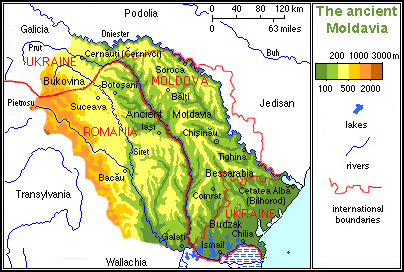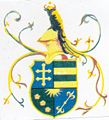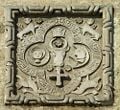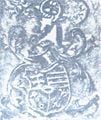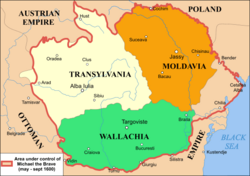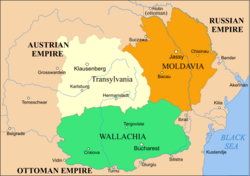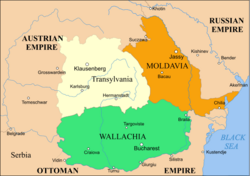Moldavia
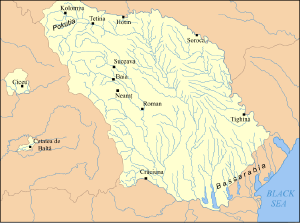
Moldavia (Romanian: Moldova) is a geographic and historical region and former principality in Eastern Europe, corresponding to the territory between Eastern Carpathians and Dniester river. An initially independent and later autonomous state, it existed from the 14th century to 1859, when it united with Wallachia as the basis of the modern Romanian state; at various times, the state included the regions of Bessarabia (with the Budjak) and all of Bukovina. Under Michael the Brave, Moldavia and Wallachia were briefly united with Transylvania which for the first time combined the three Romanian provinces as one unit. The western part of Moldavia is now part of Romania, the eastern part belongs to the Republic of Moldova, while the northern and south-eastern parts are territories of Ukraine.
Historically, Moldavia and its neighbors were geo-politically situated at the frontier between empires and culture, especially between East and West, between the Byzantines succeeded by Ottomans in the East and the European powers, including Hungary, Austria, Poland, Lithuania and Russia to the West and also to the North. Inevitably, this made the region vulnerable to conquest and for most of its history Moldavia was subject to the authority of an external power. Yet, despite conflict and confrontation, a rich culture emerged which blended East and West, creating a cultural bridge between rival civilizations. Nor was conflict constant. The early seventeenth century under Ottoman rule saw a period of peace and prosperity. The Moldavian legacy, now combined with that of its Romanian neighbors, suggests that while civilizational clash is one option, mutual enrichment and a developing consciousness that we are all members of a single human family, is another.
Geography
Geographically, Moldavia is defined by the Carpathian Mountains to the West, the Cheremosh River to the North, the Dniester River to the East and the Danube and Black Sea to the South. The Prut River flows approximately through its middle from north to south. Of early 15th century Moldavia, the biggest part is located in Romania (42 percent), followed by the Republic of Moldova (3 percent) and Ukraine (25 percent). This represents 90.5 percent of Moldova's surface and 19.5 percent of Romania's surface.
The region is mostly hilly, with a range of mountains in the west, and plain areas in the southeast. Moldavia's highest altitude is Ineu peak (2,279m), which is also the westernmost point of the region. Moldavia and Wallachia are collectively referred to in Romania as the “old Kingdom.”[1]
Name
The original and short-lived reference to the region was Bogdania, after Bogdan I, the founding figure of the principality. The names Moldavia and Moldova are derived from the name of the Moldova River, however the etymology is not known and there are several variants:
- a legend featured in Cronica Anonimă a Moldovei links it to an aurochs hunting trip of the Maramureş voivode Dragoş, and the latter's chase of a star-marked bull. Dragoş was accompanied by his female hound called Molda; when they reached shores of an unfamiliar river, Molda caught up with the animal and was killed by it. The dog's name would have been given to the river, and extended to the country.[2]
- the old German Molde, meaning "open-pit mine"
- the Gothic Mulda meaning "dust," "dirt" (cognate with the English mould), referring to the river.
- a Slavic etymology (-ova is a quite common Slavic suffix), marking the end of one Slavic genitive form, denoting ownership, chiefly of feminine nouns (i.e.: "that of Molda").
- a landowner by the name of Alexa Moldaowicz is mentioned in a 1334 document, as a local boyar (noble) in service to Yuriy II of Halych; this attests to the use of the name prior to the foundation of the Moldavian state, and could even be the source for the region's name.
In several early references, "Moldavia" is rendered under the composite form Moldo-Wallachia (in the same way Wallachia may appear as Hungro-Wallachia). Ottoman Turkish references to Moldavia included Boğdan Iflak (meaning "Bogdan's Wallachia") and Boğdan (and occasionally Kara-Boğdan - "Black Bogdania").
Flags and coats of arms
History
Early history
In the early thirteenth century, the Brodniks, a possible Slavic-Vlach vassal state of Halych, were present, alongside the Vlachs, in much of the region's territory (towards 1216, the Brodniks are mentioned as in service of Suzdal). On the border between Halych and the Brodniks, in the 11th century, a Viking by the name of Rodfos was killed in the area by Vlachs who supposedly betrayed him. In 1164, the future Byzantine Emperor Andronicus I Comnenus, was taken prisoner by Vlach shepherds around the same region.
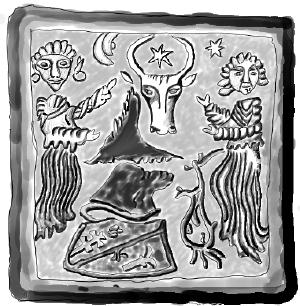
Foundation of the principality
Later in the thirteenth century, |King Charles I of Hungary attempted to expand his realm and the influence of the Roman Catholic Church eastwards after the fall of Cuman rule, and ordered a campaign under the command of Phynta de Mende (1324). In 1342 and 1345, the Hungarians were victorious in a battle against Tatars; the conflict was resolved by the death of Jani Beg, in 1357). The Polish chronicler Jan Długosz mentioned Moldavians (under the name Wallachians) as having joined a military expedition in 1342, under King Władysław I, against the Margraviate of Brandenburg.[3]
In 1353, Dragoş was sent by Louis I to establish a line of defense against the Golden Horde forces on the Siret River. This expedition resulted in a polity vassal to Hungary, centered around Baia (Târgul Moldovei or Moldvabánya).
Bogdan of Cuhea, another Vlach (voivode; commander) from Maramureş who had fallen out with the Hungarian king, crossed the Carpathians in 1359, took control of Moldavia, and succeeded in removing Moldavia from Hungarian control. His realm extended north to the Cheremosh River, while the southern part of Moldavia was still occupied by the Tatars.
After first residing in Baia, Bogdan moved Moldavia's seat to Siret (it was to remain there until Petru Muşat moved it to Suceava; it was finally moved to Iaşi under Alexandru Lăpuşneanu - in 1565). The area around Suceava, roughly correspondent to Bukovina, formed one of the two administrative divisions of the new realm, under the name Ţara de Sus (the "Upper Land"), whereas the rest, on both sides of the Prut River, formed Ţara de Jos (the "Lower Land").
Disfavored by the brief union of Angevin Poland and Hungary (the latter was still the country's overlord), Bogdan's successor Laţcu of Moldavia accepted conversion to Roman Catholicism around 1370, but his gesture was to remain without consequences. Despite remaining officially Eastern Orthodox and culturally connected with the Byzantine Empire after 1382, princes of the Muşatin family entered a conflict with the Patriarch of Constantinople over control of appointments to the newly-founded Moldavian Metropolitan seat; Patriarch Anthony IV of Constantinople| even cast an anathema over Moldavia after Roman I expelled his appointee back to Byzantium. The crisis was finally settled in favor of the Moldavian princes under Alexandru cel Bun. Nevertheless, religious policy remained complex: while conversions to faiths other than Orthodox were discouraged (and forbidden for princes), Moldavia included sizable Roman Catholic communities (Germans and Hungarians), as well as Armenians; after 1460, the country welcomed Hussite refugees (founders of Ciuburciu] and, probably, Huşi).
Early Muşatin rulers
The principality of Moldavia covered the entire geographic region of Moldavia. In various periods, various other territories were politically connected with the Moldavian principality. This is the case of the province of Pokuttya, the fiefdoms of Cetatea de Baltă and Ciceu (both in Transylvania) or, at a later date, the territories between the Dniester and the Bug Rivers.
Petru I profited from the end of the Hungarian-Polish union, and moved the country closer to the Jagiellon realm, becoming a vassal of Władysław II on September 26, 1387. This gesture was to have unexpected consequences: Petru supplied the Polish ruler with funds needed in the war against the Teutonic Knights, and was granted control over Pokuttya until the debt was to be repaid; as this is not recorded to have been carried out, the region became disputed by the two states, until it was lost by Moldavia in the Battle of Obertyn (1531). Prince Petru also expanded his rule southwards to the Danube Delta, and established a frontier with Wallachia; his son Roman I conquered the Hungarian-ruled Cetatea Albă in 1392, giving Moldavia an outlet to the Black Sea, before being toppled from the throne for supporting Theodor Koriatovich in his conflict with Vytautas the Great of Lithuania. Under Stephen I, growing Polish influence was challenged by Sigismund of Hungary, whose expedition was defeated at Ghindăoani in 1385; however, Stephen disappeared in mysterious circumstances and Yury Koriatovich of Moldavia (Vytautas' favorite) took the throne.
Alexandru cel Bun, although brought to the throne in 1400 by the Hungarians (with assistance from Mircea I of Wallachia), shifted his allegiances towards Poland (notably engaging Moldavian forces on the Polish side in the Battle of Grunwald and the Siege of Marienburg (1410), and placed his own choice of rulers in Wallachia. His reign was one of the most successful in Moldavia's history, but also saw the very first confrontation with the Ottoman Turks at Cetatea Albă in 1420, and later even a conflict with the Poles. A deep crisis was to follow Alexandru's long reign, with his successors battling each other in a succession of wars that divided the country until the murder of Bogdan II and the ascension of Petru Aron in 1451. Nevertheless, Moldavia was subject to further Hungarian interventions after that moment, as Matthias Corvinus of Hungary deposed Aron and backed Alexăndrel to the throne in Suceava. Petru Aron's rule also signified the beginning of Moldavia's Ottoman Empire allegiance, as the ruler agreed to pay tribute to Sultan Mehmed II.
Under Stephen III of Moldavia (Stephen the Great), who took the throne and subsequently came to an agreement with Kazimierz IV of Poland in 1457, the state reached its most glorious period. Stephen blocked Hungarian interventions in the Battle of Baia, invaded Wallachia in 1471, and dealt with Ottoman reprisals in a major victory (the 1475 Battle of Vaslui; after feeling threatened by Polish ambitions, he also attacked Galicia and resisted Polish reprisals in the Battle of the Cosmin Forest (1497). However, he had to surrender Chilia (Kiliya) and Cetatea Albă (Bilhorod-Dnistrovs'kyi), the two main fortresses in the Bujak, to the Ottomans in 1484, and in 1498 he had to accept Ottoman suzereignty, when he was forced to agree to continue paying tribute to Sultan Bayezid II. Following the taking of Khotyn and Pokuttya, Stephen's rule also brought a brief extension of Moldavian rule into Transylvania: Cetatea de Baltă and Ciceu became his fiefs in 1489.
Under Bogdan III cel Orb, Ottoman overlordship was confirmed in the shape that would rapidly evolve into control over Moldavia's affairs. Petru Rareş, who reigned in the 1530s and 1540s, clashed with the Habsburg Monarchy over his ambitions in Transylvania (losing possessions in the region to George Martinuzzi), was defeated in Pokuttya by Poland, and failed in his attempt to extricate Moldavia from Ottoman rule – the country lost Bender to the Ottomans, who included it in their Silistra eyalet' (province)'.
Renaissance Moldavia
A period of profound crisis followed. Moldavia stopped issuing its own coinage circa 1520, under Prince Ştefăniţă, when it was confronted with rapid depletion of funds and rising demands from the Sultan. Such problems became endemic when the country, brought into the Great Turkish War, suffered the impact of the Stagnation of the Ottoman Empire; at one point, during the 1650s and 1660s, princes began relying on counterfeit coinage (usually copies of Swedish riksdalers, as was that issued by Eustratie Dabija). The economic decline was accompanied by a failure to maintain state structures: the feudal-based Moldavian military forces were no longer convoked, and the few troops maintained by the rulers remained professional mercenaries such as the seimeni.
However, Moldavia and the similarly-affected Wallachia remained both important sources of income for the Ottoman Empire and relatively prosperous agricultural economies (especially as suppliers of grain and cattle – the latter was especially relevant in Moldavia, which remained an under-populated country of pastures). In time, much of the resources were tied to the Ottoman economy, either through monopolies on trade which were only lifted in 1829, after the Treaty of Adrianople (which did not affect all domains directly), or through the raise in direct taxes - the one demanded by the Ottomans from the princes, as well as the ones demanded by the princes from the country's population. Taxes were directly proportional with Ottoman requests, but also with the growing importance of Ottoman appointment and sanctioning of princes in front of election by the boyars and the boyar Council – Sfatul boieresc (drawing in a competition among pretenders, which also implied the intervention of creditors as suppliers of bribes). The fiscal system soon included taxes such as the văcărit (a tax on head of cattle), first introduced by Iancu Sasul in the 1580s.
The economic opportunities offered brought about a significant influx of Greek and Levantine financiers and officials, who entered a stiff competition with the high boyars over appointments to the Court. As the manor system suffered the blows of economic crises, and in the absence of salarisation (which implied that persons in office could decide their own income), obtaining princely appointment became the major focus of a boyar's career. Such changes also implied the decline of free peasantry and the rise of serfdom, as well as the rapid fall in the importance of low boyars (a traditional institution, the latter soon became marginal, and, in more successful instances, added to the population of towns); however, they also implied a rapid transition towards a monetary economy, based on exchanges in foreign currency. Serfdom was doubled by the much less numerous slave population, comprised of migrant Roma and captured Nogais.
The conflict between princes and boyars was to become exceptionally violent – the latter group, who frequently appealed to the Ottoman court in order to have princes comply with its demands, was persecuted by rulers such as Alexandru Lăpuşneanu and Ioan Vodă cel Cumplit. Ioan Vodă's revolt against the Ottomans ended in his execution (1574). The country descended into political chaos, with frequent Ottoman and Tatar incursions and pillages. The claims of Muşatins to the crown and the traditional system of succession were ended by scores of illegitimate reigns; one of the usurpers, Ioan Iacob Heraclid, was a Protestant Greek who encouraged the Renaissance and attempted to introduce Lutheranism to Moldavia.
In 1595, the rise of the Movileşti boyars to the throne with Ieremia Movilă coincided with the start of frequent anti-Ottoman and anti-Habsburg military expeditions of the Polish-Lithuanian Commonwealth into Moldavian territory (the Moldavian Magnate Wars'), and rivalries between pretenders to the Moldavian throne encouraged by the three competing powers. The Wallachian prince Michael the Brave deposed Prince Ieremia in 1600, and managed to become the very first monarch to unite Moldavia, Wallachia, and Transylvania under his rule; the episode ended in Polish conquests of lands down to Bucharest, which was itself ended by the outbreak of the Polish-Sweden War (1600-1611) and by the reestablishment of Ottoman rule. Polish incursions were dealt a blow by the Ottomans during the 1620 Battle of Cecora, which also saw an end to the reign of Gaspar Graziani.
The following period of relative peace saw the more prosperous and prestigious rule of Vasile Lupu, who took the throne as a boyar appointee in 1637, and began battling his rival Gheorghe Ştefan, as well as the Wallachian prince Matei Basarab – however, his invasion of Wallachia with the backing of Cossack Hetman (chief) Bohdan Khmelnytsky ended in disaster at the Battle of Finta (1653). A few years later, the ant-Ottoman Wallachian prince, Constantin Şerban occupied Moldavia for two short intervals who clashed with the first ruler of the Ghica family, Gheorghe Ghica. In the early 1680s, Moldavian troops under George Ducas intervened in Right-bank Ukraine and assisted Mehmed IV in the Battle of Vienna, only to suffer the effects of the Great Turkish War.
Eighteenth century
During the late seventeenth century, Moldavia became the target of the Russian Empire's southwards expansion, inaugurated by Peter the Great during the Russo-Turkish War of 1710-1711; Prince Dimitrie Cantemir's siding with Peter and open anti-Ottoman rebellion, ended in defeat at Stănileşti, provoked Sultan Ahmed III's reaction, and the official discarding of recognition of local choices for princes, imposing instead a system which relied solely on Ottoman approval – the Phanariote epoch, inaugurated by the reign of Nicholas Mavrocordatos. The Phanariotes were wealthy Greeks who paid for the Voivodership, and were invested into office in Istanbul. Short and frequently ended through violence, Phanariote rules were usually marked by political corruption, intrigue, and high taxation, as well as by sporadic incursions of Habsburg and Russian armies deep into Moldavian territory; nonetheless, they also saw attempts at legislative and administrative modernization inspired by The Enlightenment (such as Constantine Mavrocordatos' decision to salirize public offices, to the outrage of boyars, and the abolition of serfdom in 1749, as well as Scarlat Callimachi's Code), and signified a decrease in Ottoman demands after the threat of Russian annexation became real and the prospects of a better life led to waves of peasant emigration to neighboring lands. The effects of Ottoman control were also made less notable after the 1774 Treaty of Kucuk Kaynarca allowed Russia to intervene in favor of Ottoman subjects of the Eastern Orthodox faith - leading to campaigns of petitioning by the Moldavian boyars against princely politics.
In 1712, Khotyn was taken over by the Ottomans, and became part of a defensive system that Moldavian princes were required to maintain, as well as an area for Islamic colonization (the Laz community). Moldavia also lost Bukovina, Suceava included, to the Habsburgs in 1772, which meant both an important territorial loss and a major blow to the cattle trade (as the region stood on the trade route to Central Europe). The 1792 Treaty of Jassy forced the Ottoman Empire to cede all of its holdings in what is now Transnistria to Russia, which made Russian presence much more notable, given that the Empire acquired a common border with Moldavia. The first effect of this was the cession of Bessarabia to the Russian Empire, in 1812 (through the Treaty of Bucharest).
Organic statute, revolution, and union with Wallachia
Phanariote rules were officially ended after the 1821 occupation of the country by Alexander Ypsilantis' Filiki Eteria during the Greek War of Independence; the subsequent Ottoman retaliation brought the rule of Ioan Sturdza, considered as the first one of a new system – especially since, in 1826, the Ottomans and Russia agreed to allow for the election by locals of rulers over the two Danubian Principalities, and convened on their mandating for seven-year terms. In practice, a new fundament to reigns in Moldavia was created by the Russo-Turkish War of 1828-1829, and a period of Russian domination over the two countries which ended only in 1856: begun as a military occupation under the command of Pavel Kiselyov, Russian domination gave Wallachia and Moldavia, which were not removed from nominal Ottoman control, the modernizing Organic Statute (the first document resembling a constitution, as well as the first one to regard both principalities). After 1829, the country also became an important destination for immigration of Ashkenazi Jews from Central Europe and areas of Russia.
The first Moldavian rule established under the Statute, that of Mihail Sturdza, was nonetheless ambivalent: eager to reduce abuse of office, Sturdza introduced reforms (the abolition of slavery, secularization, economic rebuilding), but he was widely seen as enforcing his own power over that of the newly-instituted consultative Assembly. A supporter of the union of his country with Wallachia and of Romanian Romantic nationalism, he obtained the establishment of a customs union between the two countries (1847) and showed support for radical projects favored by low boyars; nevertheless, he clamped down with noted violence the Moldavian revolutionary attempt in the last days of March 1848. Grigore Alexandru Ghica allowed the exiled revolutionaries to return to Moldavia in 1853, which led to the creation of Partida Naţională (the “National Party”), a trans-boundary group of radical union supporters that campaigned for a single state under a foreign dynasty.
Russian domination ended abruptly after the Crimean War, when the Treaty of Paris placed the two principalities under the tutelage of the Great Powers - Great Britain, the Austrian Empire, the French Empire|French Empire, the Kingdom of Piedmont-Sardinia, Prussia) and Russia. Officially, Moldavia remained under Ottoman suzerainty. Due to Austrian and Ottoman opposition and British reserves, the union program as demanded by radical campaigners was debated intensely. In September 1857, given that Caimacam[4] Nicolae Vogoride had perpetrated fraud in elections in Moldavia in July, the Powers allowed the two states to convene Ad-hoc divans (councils), which were to decide a new constitutional framework; the result showed overwhelming support for the union, as the creation of a liberal and neutral state. After further meetings among leaders of tutor states, an agreement was reached (the Paris Convention), whereby a limited union was to be enforced – separate governments and thrones, with only two bodies (a Court of Cassation and a Central Commission residing in Focşani; it also stipulated that an end to all privilege was to be passed into law, and awarded back to Moldavia the areas around Bolhrad, Cahul, and Izmail.
However, the Convention failed to note whether the two thrones could not be occupied by the same person, allowing Partida Naţională to introduce the candidacy of Alexander John Cuza in both countries. On January 17 (January 5, 1859 Old Style and New Style dates), he was elected prince of Moldavia by the respective electoral body. After street pressure over the much more conservative body in Bucharest, Cuza was elected in Wallachia as well (February 5/January 24). Exactly three years later, after diplomatic missions that helped remove opposition to the action, the formal union created Romania and instituted Cuza as Domnitor (all legal matters were clarified after the replacement of the prince with Carol of Hohenzollern-Sigmaringen in April 1866, and the creation of an independent Kingdom of Romania in 1881) - this officially ended the existence of the Principality of Moldavia. After World War I and the collapse of the Austria-Hungarian Empire, Transylvania, Bessarabia, Bukovina united with Romania. The three Romanian provinces had not been unified since the start of the seventeenth century.
Legacy
For much of its history, Moldavia was part of a buffer-zone between different civilizations and cultures, including the Byzantine, Ottoman, Russian and those of such European states and powers as Austria, Poland and Hungary. Throughout Moldavia’s history, territory has been gained and lost due to conquest, diplomacy and occupation, and has not survived as a distinct polity. Given the degree of outside interference in their affairs, which continued through the communist period of Romania (1947-1989), it is remarkable that the people of the three principalities retained their language, culture and religion, remaining the only predominantly Orthodox state with a predominantly Latin population.
Traditionally, the people of Moldavia, like those of their two neighboring Romanian states, were open to the culture of both the East and of the West, thus:
From the first mediaeval forms of state organization, in the 14th century, down to the eighteenth century, Romanian culture and civilization showed two major trends: one towards Central and Western Europe and the other oriented towards the Eastern Orthodox world. Whether one or the other prevailed at various times in history depended on the region and the field. Architecture developed both trends for centuries and gave interesting forms of synthesis; painting, linked to religious canons, was closer to the great Byzantine tradition.”[5]
This legacy represents a significant contribution towards bridge-building between cultures, suggesting that while conflict, confrontation and competition have often characterized relations between the different empires, this is not the only mode of contact. The point at which cultures meet can also become a place where each benefits from contact with the other.
Notes
- ↑ Steven D. Roper and Florin Fesnic. 2003. "Historical Legacies and their Impact on Post-Communist Voting Behavior." Europe-Asia Studies 55 (1) (2003): 130 FN 19.
- ↑ Velciu. 1989.; Britannica Vol 33. (1911 ed.), 834.
- ↑ Jan Lugosz, Maurice Michael and Paul Smith. The annals of Jan Długosz: an English abridgement. (Chichester, UK: 1997), 273.
- ↑ District governor in Ottoman administration.
- ↑ Romania: Culture. Romania Folk Life Festival, 1999. Retrieved September 14, 2008.
ReferencesISBN links support NWE through referral fees
- Denize, Eugen. 2004. Stephen the Great and his reign. Bucharest, RO: Romanian Cultural Institute Publishing House. ISBN 9789735774035.
- Dima, Nicholas. 1991. From Moldavia to Moldova: the Soviet-Romanian territorial dispute. East European monographs, no. 309. Boulder, CO: East European Monographs. ISBN 9780880332057.
- East, W. Gordon. 1973. The union of Moldavia and Wallachia, 1859; an episode in diplomatic history. New York, NY: Octagon Books. ISBN 9780374924508.
- Lugosz, Jan, Maurice Michael, and Paul Smith. 1997. The annals of Jan Długosz: an English abridgement. Chichester, UK: IM. ISBN 9781901019001.
- Roper, Steven D. and Florin Fesnic. 2003. Historical Legacies and their Impact on Post-Communist Voting Behavior. Europe-Asia Studies. 55:1:119-131.
- Velciu, Dumitru. 1989. Cronica anonimă a Moldovei, 1661-1709: Pseudo-Nicolae Costin : (studiu critic). Bucureşti, RO: Minerva. ISBN 9789732100868.
- Wilkinson, William. 1971. An account of the principalities of Wallachia and Moldavia. New York, NY: Arno Press. ISBN 9780405027796.
- Williams, Nicola. 1998. Romania & Moldova. Hawthorn, CA: Lonely Planet. ISBN 9780864423290.
This article incorporates text from the Encyclopædia Britannica Eleventh Edition, a publication now in the public domain.
Credits
New World Encyclopedia writers and editors rewrote and completed the Wikipedia article in accordance with New World Encyclopedia standards. This article abides by terms of the Creative Commons CC-by-sa 3.0 License (CC-by-sa), which may be used and disseminated with proper attribution. Credit is due under the terms of this license that can reference both the New World Encyclopedia contributors and the selfless volunteer contributors of the Wikimedia Foundation. To cite this article click here for a list of acceptable citing formats.The history of earlier contributions by wikipedians is accessible to researchers here:
The history of this article since it was imported to New World Encyclopedia:
Note: Some restrictions may apply to use of individual images which are separately licensed.
